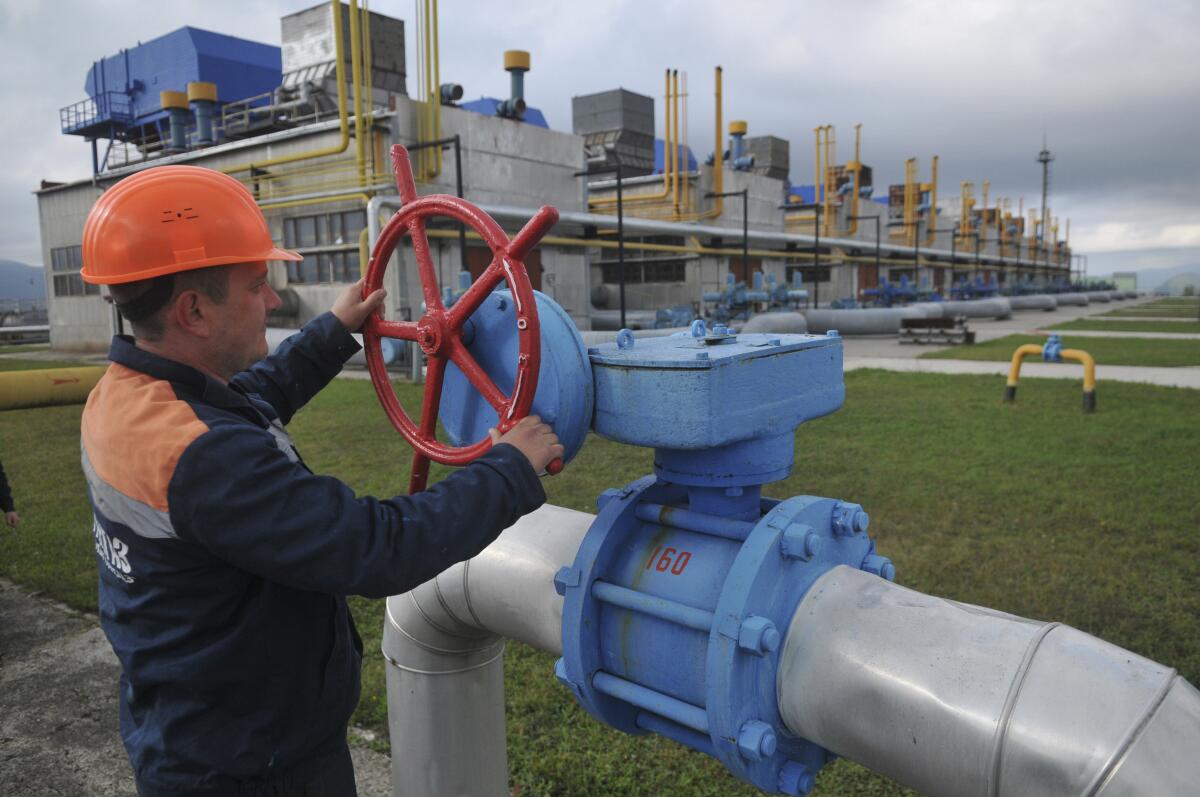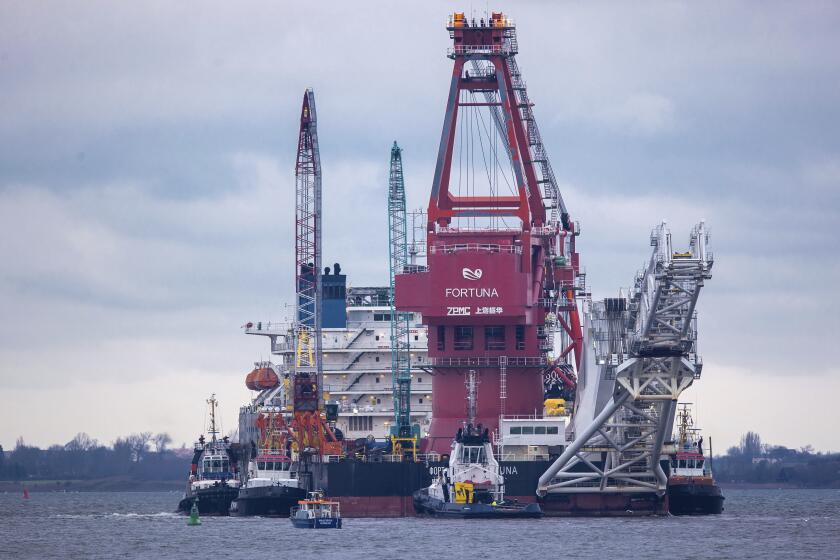What happens to Europe’s energy supply if Russia cuts gas exports? An explainer

- Share via
FRANKFURT, Germany — Fears are rising over what would happen to Europe’s energy supply if Russia were to invade Ukraine and then shut off natural gas exports in retaliation for U.S. and European sanctions.
The tensions show the risk of Europe’s reliance on Russia for energy, which supplies about one-third of the continent’s natural gas. And Europe’s stockpile is already low. Although the U.S. has pledged to help by boosting exports of liquefied natural gas, or LNG, there’s only so much it can produce at once.
It leaves Europe in a potential crisis, with its gas already sapped by a cold winter last year, a summer with little renewable energy generation and Russia delivering less than usual. Prices have skyrocketed, squeezing households and businesses.
Here’s what to know about Europe’s energy supply if tensions boil over into war and Russia is hit with sanctions:
Will Russia cut off gas supplies to Europe?
No one knows for sure, but a complete shutoff is seen as unlikely, because it would be mutually destructive.
Russian officials have not signaled that they would consider cutting supplies in the case of new sanctions. Moscow relies on energy exports, and though it just signed a gas deal with China, Europe is a key source of revenue.
Europe is likewise dependent on Russia, so any Western sanctions would probably avoid directly targeting Russian energy supplies.
Placing sanctions on Russia’s energy exports could be the most effective hammer against Putin’s aggression against Ukraine.
More likely, experts say, would be Russia withholding gas sent through pipelines crossing Ukraine. Russia pumped 175 billion cubic meters of gas into Europe last year, nearly a quarter of it through those pipelines, according to S&P Global Platts. That would leave pipelines under the Baltic Sea and through Poland still operating.
“I think in the event of even a less severe Russian attack against Ukraine, the Russians are almost certain to cut off gas transiting Ukraine on the way to Germany,” said former U.S. diplomat Dan Fried, who as State Department coordinator for sanctions policy helped craft 2014 measures against Russia when it invaded and annexed Ukraine’s Crimean peninsula.
Russia could then offer to make up the lost gas if Germany approves the contentious new Nord Stream 2 pipeline, whose operators could face potential U.S. sanctions even though a recent vote to that effect failed.
U.S. national security advisor Jake Sullivan said Sunday on NBC’s “Meet the Press” that the Biden administration has coordinated with its allies and that “if Russia invades Ukraine, one way or another, Nord Stream 2 will not move forward.”
Interrupting gas supplies beyond the Ukrainian pipelines is less likely: “If they push it too far, they’re going to make a breach with Europe irreparable, and they have to sell the oil and gas someplace,” Fried said.
What can the U.S. do?
It’s a major gas producer and already is sending record levels of liquefied natural gas, or LNG, by ship worldwide. It could help Europe only a little.
“We’re talking about small increases to the size of U.S. exports, whereas the hole that Europe would need to fill if Russia backed away or if Europe cut Russia off would be much larger than that,” said Ross Wyeno, lead analyst for Americas LNG at S&P.
Biden administration imposes sanctions on three Russian ships and firms involved in constructing a controversial gas pipeline from Russia to Europe.
The Biden administration has been talking with gas producers worldwide about whether they can boost output and ship to Europe, and it has been working to identify supplies of natural gas from North Africa, the Middle East, Asia and the U.S.
The administration also is talking with buyers about holding off.
“Is there some other country that was planning to get an LNG shipment that doesn’t need it and could give it to Europe?” said Amy Myers Jaffe, managing director of the Climate Policy Lab at Tufts University, mentioning Brazil or countries in Asia.
Over the last month, two-thirds of American LNG exports went to Europe. Some ships filled with LNG were heading to Asia but turned around to go to Europe because buyers there offered to pay higher prices, S&P said.
Is there enough liquefied gas worldwide to solve the problem?
Not in the event of a full cutoff, and it can’t be increased overnight. Export terminals cost billions of dollars to build and are working at capacity in the U.S.
Even if all of Europe’s LNG import facilities were operating at capacity, the amount of gas would add up to only about two-thirds of what Russia sends via pipelines, Jaffe said.
Plenty of residents of Kyiv don’t seem to think their capital is on borrowed time, but some are girding for a potential Russian invasion anyway.
And there could be challenges distributing the LNG to parts of Europe that have fewer pipeline connections.
If Russia stopped sending just the gas that goes through Ukraine, it would take the equivalent of about 1.27 shiploads of additional LNG per day to replace that supply, said Luke Cottell, senior LNG analyst at S&P. Russia also could reroute some of that gas through other pipelines, reducing the need for additional LNG to about a half-shipload per day, he said.
Is Russia already supplying less gas?
Russia has been fulfilling its long-term contracts to supply gas to Europe, but it has been selling less on the spot market and hasn’t been filling the storage containers it owns in Europe, experts say.
“It’s already happened. It’s not theoretical,” Jaffe said.
Russian cutbacks to spot gas supplies have contributed to sharply higher natural gas prices in Europe. They went as high as 166 euros ($190) per megawatt hour in December, more than eight times their level at the start of 2021. Prices have fallen to under 80 euros per kilowatt hour as more LNG arrives.
But consumers are feeling the crunch in higher electricity and gas bills. European governments are rolling out subsidies and tax breaks to ease the financial stress on households.
Is there impact in the U.S.?
As the U.S. ramped up LNG exports, domestic prices of natural gas also rose. More than 10% of gas produced in the U.S. last year was exported, said Clark Williams-Derry, an analyst at the Institute for Energy Economics and Financial Analysis.
U.S. gas prices spiked by more than 30% in the last week of January, primarily because of an approaching winter storm in New England, Williams-Derry said. But prices also were affected by tighter U.S. supplies amid uncertainty over Russia, he said.
News Alerts
Get breaking news, investigations, analysis and more signature journalism from the Los Angeles Times in your inbox.
You may occasionally receive promotional content from the Los Angeles Times.
“Russia is disturbing European gas markets, with the U.S. talking about exporting basically the next ‘Berlin airlift’ for natural gas to Europe,” he said.
If the U.S. pushes for increased LNG exports, prices at home would probably rise, Williams-Derry added.
Ten senators, led by Democrat Jack Reed of Rhode Island and Independent Angus King of Maine, recently urged the Energy Department to study the effect of higher exports on domestic prices and pause approvals of proposed terminals. They said they understood that “geopolitical factors” give rise to sending more gas.
“However, the administration must also consider the potential increase in cost to American families,’’ the senators said.
More to Read
Sign up for Essential California
The most important California stories and recommendations in your inbox every morning.
You may occasionally receive promotional content from the Los Angeles Times.












